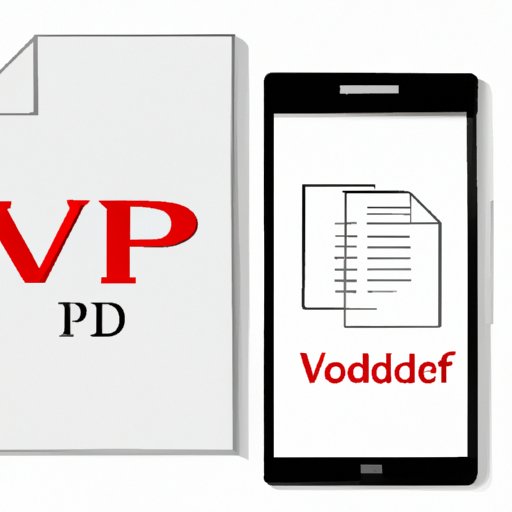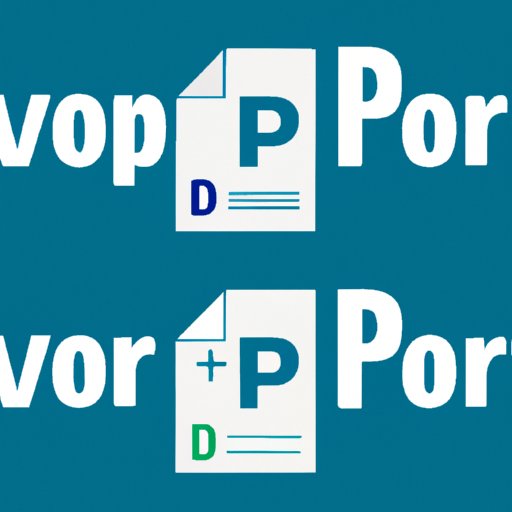I. Introduction
Have you ever been frustrated by the inability to share a document with someone because they don’t have the same software as you? Or maybe you’ve sent a Word document to someone only to have them make changes that you didn’t intend. The solution is simple: convert your Word document to a PDF file. In this article, we will explore various methods for converting Word to PDF, including online tools, built-in features, Mac-based tools, and mobile apps. Additionally, we will discuss the benefits of using PDF files and how to troubleshoot common conversion errors.
II. The Simplest Method to Convert a Word Document to PDF
The easiest way to convert a Word document to a PDF file is by using an online conversion tool. Two of the most popular online tools are Smallpdf and PDF24. Here are the steps to convert a Word document using Smallpdf:
1. Open your web browser and navigate to Smallpdf.com.
2. Select “Word to PDF” from the list of conversion options.
3. Upload your Word document by clicking on the green “Choose Files” button or by dragging and dropping your file into the designated box.
4. Wait for the file to upload and convert.
5. Download your PDF file.
PDF24 offers a similar conversion process. Simply go to PDF24.org and follow the same basic steps.
III. Using Word’s built-in ‘Save as PDF’ Feature: A Step-by-Step Guide
If you don’t want to use an online tool, Microsoft Word has a built-in “Save as PDF” feature. Here’s how to use it:
1. Open your Word document.
2. Click “File” in the top left corner.
3. Select “Export” from the menu.
4. Choose “Create PDF/XPS Document” and click “Create PDF/XPS”.
5. Select a location to save your PDF file, and click “Publish”.
While this method may be more convenient if you’re already using Word, it does not have as many features as some of the other conversion tools.
IV. Converting Word to PDF on Mac: Top Four Tools
If you’re using a Mac, there are several tools that you can use to convert Word documents to PDF files. Here are the four most popular tools:
1. Pages: A free tool that comes pre-installed on all Macs.
2. Adobe Acrobat Pro DC: A professional tool with many features, including the ability to edit PDF files.
3. PDF Expert: A user-friendly and affordable option.
4. Microsoft Word: If you have a Mac version of Word, you can use the built-in “Save as PDF” feature mentioned earlier.
Each of these tools has its own set of pros and cons depending on your needs, so it’s important to do your research before choosing one.

V. Converting Word to PDF on Mobile: A Walkthrough of the Best Apps
Many of us work on our phones more than we realize, so it’s important to have tools that allow us to easily convert Word documents to PDF files on the go. Here are some of the best mobile apps for doing just that:
1. Adobe Acrobat Reader: A free app that includes a built-in converter.
2. Google Drive: Save your Word document to Google Drive and then download it as a PDF.
3. Microsoft Word: The mobile app version of Word includes the same “Save as PDF” feature as the desktop version.
4. PDF Converter: A user-friendly app that offers many features, including the ability to merge multiple PDF files.
As with the Mac-based tools, it’s important to choose the app that best fits your needs.
VI. The Benefits of Converting Word to PDF: Why Every Document Needs a PDF Version
Why convert a Word document to a PDF file? There are several benefits, including:
1. Consistent Formatting: PDF files look the same on every device, ensuring that your formatting stays intact.
2. Security: PDF files are more secure than Word documents, as they cannot be easily edited without specialized software.
3. Versatility: PDF files can be easily shared and viewed on any device or operating system.
4. Professionalism: PDF files are often seen as more professional than Word documents, as they are commonly used in the business world.
VII. How to Convert Multiple Word Files into a Single PDF Document
Sometimes, you may want to combine several Word documents into a single PDF file. This is easily accomplished using an online tool like Smallpdf:
1. Navigate to Smallpdf.com.
2. Select “Merge PDF” from the list of conversion options.
3. Upload your Word files by clicking on the green “Choose Files” button or by dragging and dropping your files into the designated box.
4. Wait for the files to upload and merge.
5. Download your PDF file.
VIII. Troubleshooting Common Errors When Converting Word to PDF
While converting Word to PDF is usually a straightforward process, there are some common errors that may occur. Here are a few solutions to some of the most common errors:
1. Corrupted File: If your Word file is corrupted, you may not be able to convert it to a PDF. Try opening the file in Word and saving it as a new document.
2. Poor Quality: If your PDF file looks blurry or pixelated, try adjusting the resolution of the converted file in your conversion tool’s settings.
3. Large File Size: If your PDF file is too large, try reducing the size of your Word document by compressing images or removing unnecessary elements before converting.
4. Unexpected Formatting: If your PDF file looks different from your Word document, try converting the file using a different tool or adjusting the conversion settings.
IX. Conclusion
Converting Word documents to PDF files is a simple and versatile process that can make sharing and viewing documents much easier. Whether you choose to use an online tool, built-in features, Mac-based tools, or mobile apps, there are many options to fit your needs. Additionally, the benefits of using PDF files far outweigh any drawbacks. With this comprehensive guide and troubleshooting tips, you’ll be able to convert your Word documents to PDF files with ease.
